Globalisation's Impact on Culture: Homogenization and Heterogenization
VerifiedAdded on 2023/01/12
|6
|1182
|97
Report
AI Summary
This report provides an overview of globalization and its impact on culture, focusing on the interconnectedness of individuals, information, and economies. It delves into the concepts of cultural homogenization and heterogenization, exploring how globalization influences cultural differences and the spread of global brands and lifestyles. The report analyzes these aspects in relation to food and beverage consumption, highlighting the homogenization process in the industry and its effects on food processing and preservation. Furthermore, it discusses the advantages and disadvantages of homogenization and heterogenization, concluding that both aspects are significantly based on globalization, impacting cultural dynamics, international business and economic decisions. The report also references the impact of non-American cultures on Western societies, showing how globalisation encourages cultural exchange and innovation.

Question
Paraphrase This Document
Need a fresh take? Get an instant paraphrase of this document with our AI Paraphraser
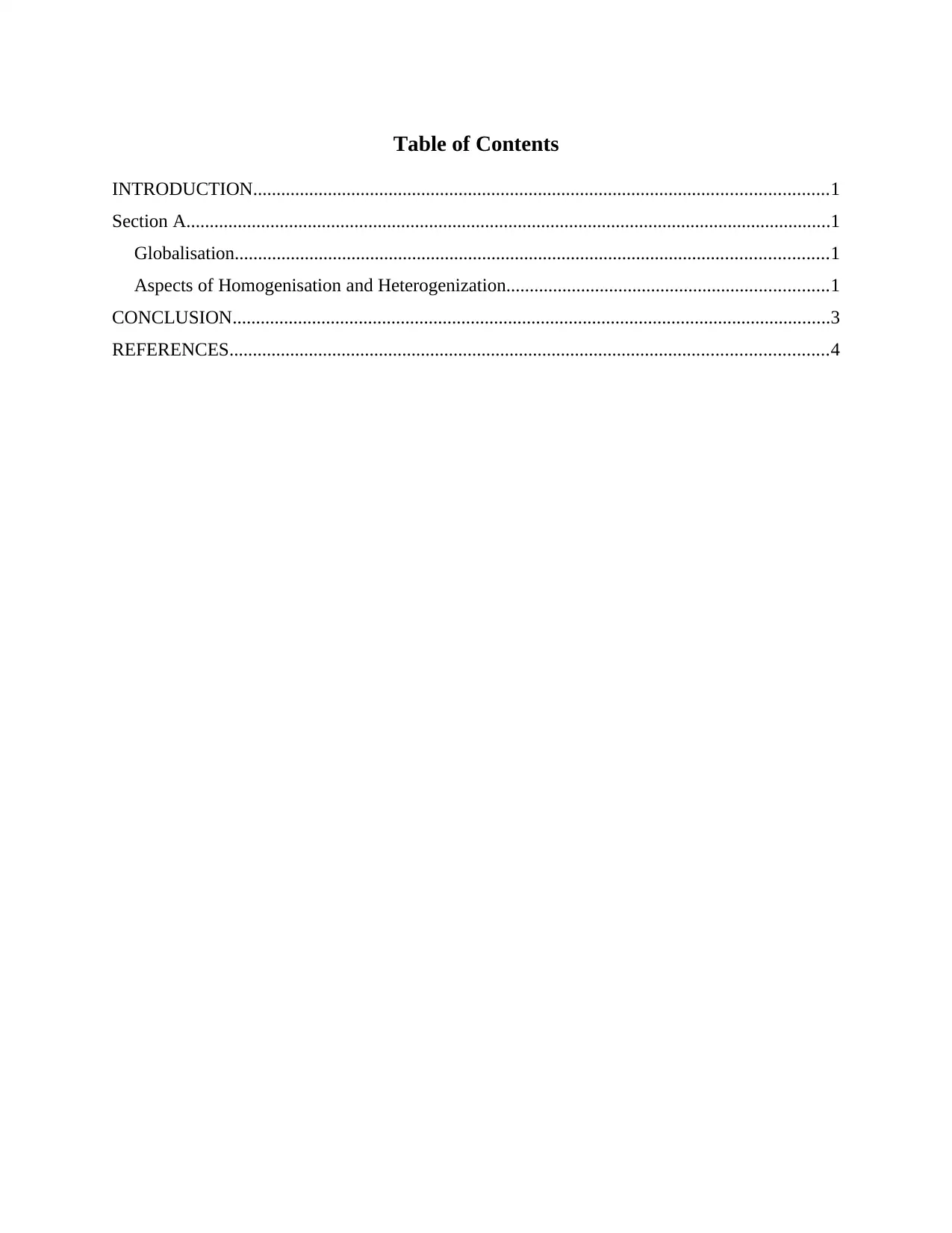
Table of Contents
INTRODUCTION...........................................................................................................................1
Section A..........................................................................................................................................1
Globalisation...............................................................................................................................1
Aspects of Homogenisation and Heterogenization.....................................................................1
CONCLUSION................................................................................................................................3
REFERENCES................................................................................................................................4
INTRODUCTION...........................................................................................................................1
Section A..........................................................................................................................................1
Globalisation...............................................................................................................................1
Aspects of Homogenisation and Heterogenization.....................................................................1
CONCLUSION................................................................................................................................3
REFERENCES................................................................................................................................4
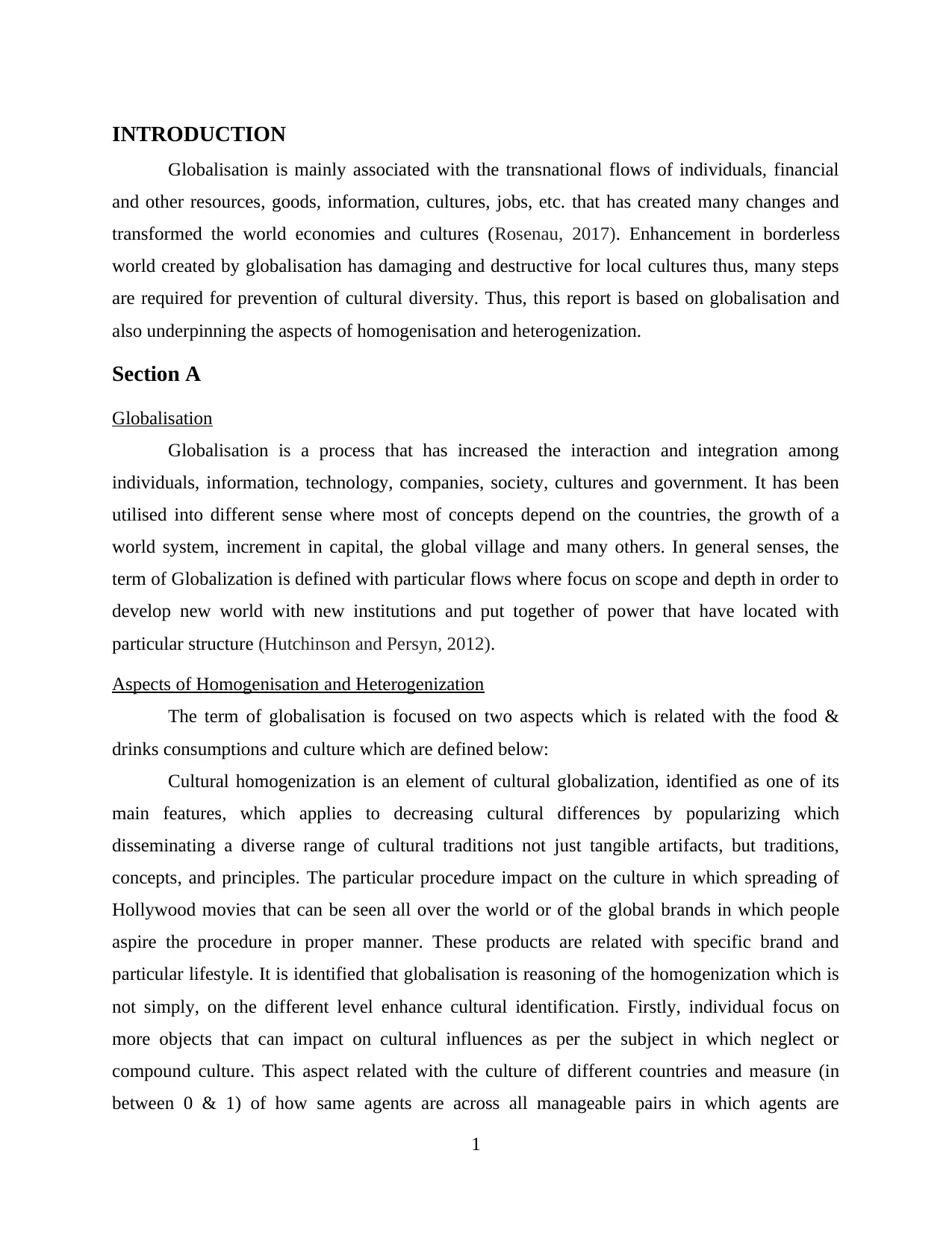
INTRODUCTION
Globalisation is mainly associated with the transnational flows of individuals, financial
and other resources, goods, information, cultures, jobs, etc. that has created many changes and
transformed the world economies and cultures (Rosenau, 2017). Enhancement in borderless
world created by globalisation has damaging and destructive for local cultures thus, many steps
are required for prevention of cultural diversity. Thus, this report is based on globalisation and
also underpinning the aspects of homogenisation and heterogenization.
Section A
Globalisation
Globalisation is a process that has increased the interaction and integration among
individuals, information, technology, companies, society, cultures and government. It has been
utilised into different sense where most of concepts depend on the countries, the growth of a
world system, increment in capital, the global village and many others. In general senses, the
term of Globalization is defined with particular flows where focus on scope and depth in order to
develop new world with new institutions and put together of power that have located with
particular structure (Hutchinson and Persyn, 2012).
Aspects of Homogenisation and Heterogenization
The term of globalisation is focused on two aspects which is related with the food &
drinks consumptions and culture which are defined below:
Cultural homogenization is an element of cultural globalization, identified as one of its
main features, which applies to decreasing cultural differences by popularizing which
disseminating a diverse range of cultural traditions not just tangible artifacts, but traditions,
concepts, and principles. The particular procedure impact on the culture in which spreading of
Hollywood movies that can be seen all over the world or of the global brands in which people
aspire the procedure in proper manner. These products are related with specific brand and
particular lifestyle. It is identified that globalisation is reasoning of the homogenization which is
not simply, on the different level enhance cultural identification. Firstly, individual focus on
more objects that can impact on cultural influences as per the subject in which neglect or
compound culture. This aspect related with the culture of different countries and measure (in
between 0 & 1) of how same agents are across all manageable pairs in which agents are
1
Globalisation is mainly associated with the transnational flows of individuals, financial
and other resources, goods, information, cultures, jobs, etc. that has created many changes and
transformed the world economies and cultures (Rosenau, 2017). Enhancement in borderless
world created by globalisation has damaging and destructive for local cultures thus, many steps
are required for prevention of cultural diversity. Thus, this report is based on globalisation and
also underpinning the aspects of homogenisation and heterogenization.
Section A
Globalisation
Globalisation is a process that has increased the interaction and integration among
individuals, information, technology, companies, society, cultures and government. It has been
utilised into different sense where most of concepts depend on the countries, the growth of a
world system, increment in capital, the global village and many others. In general senses, the
term of Globalization is defined with particular flows where focus on scope and depth in order to
develop new world with new institutions and put together of power that have located with
particular structure (Hutchinson and Persyn, 2012).
Aspects of Homogenisation and Heterogenization
The term of globalisation is focused on two aspects which is related with the food &
drinks consumptions and culture which are defined below:
Cultural homogenization is an element of cultural globalization, identified as one of its
main features, which applies to decreasing cultural differences by popularizing which
disseminating a diverse range of cultural traditions not just tangible artifacts, but traditions,
concepts, and principles. The particular procedure impact on the culture in which spreading of
Hollywood movies that can be seen all over the world or of the global brands in which people
aspire the procedure in proper manner. These products are related with specific brand and
particular lifestyle. It is identified that globalisation is reasoning of the homogenization which is
not simply, on the different level enhance cultural identification. Firstly, individual focus on
more objects that can impact on cultural influences as per the subject in which neglect or
compound culture. This aspect related with the culture of different countries and measure (in
between 0 & 1) of how same agents are across all manageable pairs in which agents are
1
⊘ This is a preview!⊘
Do you want full access?
Subscribe today to unlock all pages.

Trusted by 1+ million students worldwide
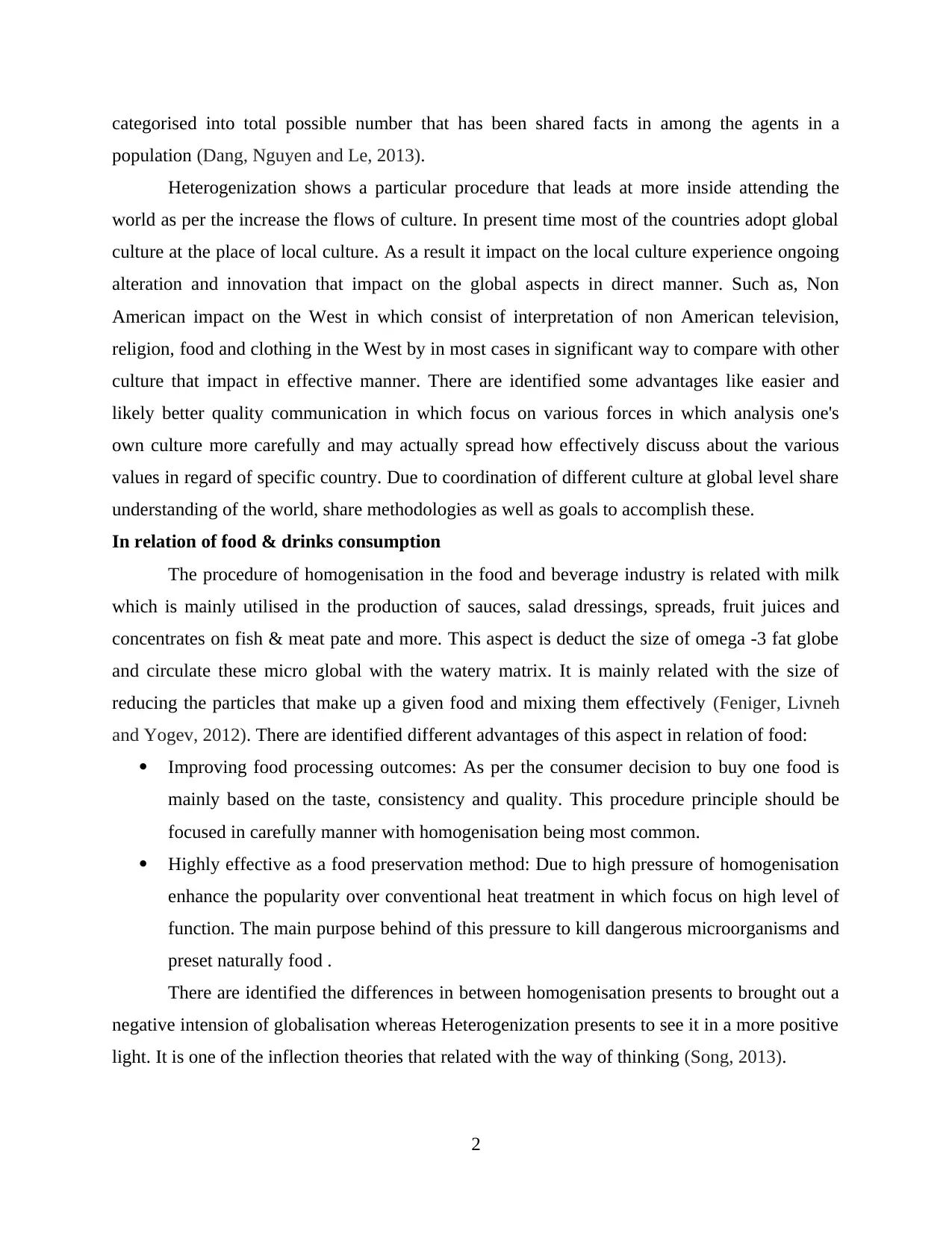
categorised into total possible number that has been shared facts in among the agents in a
population (Dang, Nguyen and Le, 2013).
Heterogenization shows a particular procedure that leads at more inside attending the
world as per the increase the flows of culture. In present time most of the countries adopt global
culture at the place of local culture. As a result it impact on the local culture experience ongoing
alteration and innovation that impact on the global aspects in direct manner. Such as, Non
American impact on the West in which consist of interpretation of non American television,
religion, food and clothing in the West by in most cases in significant way to compare with other
culture that impact in effective manner. There are identified some advantages like easier and
likely better quality communication in which focus on various forces in which analysis one's
own culture more carefully and may actually spread how effectively discuss about the various
values in regard of specific country. Due to coordination of different culture at global level share
understanding of the world, share methodologies as well as goals to accomplish these.
In relation of food & drinks consumption
The procedure of homogenisation in the food and beverage industry is related with milk
which is mainly utilised in the production of sauces, salad dressings, spreads, fruit juices and
concentrates on fish & meat pate and more. This aspect is deduct the size of omega -3 fat globe
and circulate these micro global with the watery matrix. It is mainly related with the size of
reducing the particles that make up a given food and mixing them effectively (Feniger, Livneh
and Yogev, 2012). There are identified different advantages of this aspect in relation of food:
Improving food processing outcomes: As per the consumer decision to buy one food is
mainly based on the taste, consistency and quality. This procedure principle should be
focused in carefully manner with homogenisation being most common.
Highly effective as a food preservation method: Due to high pressure of homogenisation
enhance the popularity over conventional heat treatment in which focus on high level of
function. The main purpose behind of this pressure to kill dangerous microorganisms and
preset naturally food .
There are identified the differences in between homogenisation presents to brought out a
negative intension of globalisation whereas Heterogenization presents to see it in a more positive
light. It is one of the inflection theories that related with the way of thinking (Song, 2013).
2
population (Dang, Nguyen and Le, 2013).
Heterogenization shows a particular procedure that leads at more inside attending the
world as per the increase the flows of culture. In present time most of the countries adopt global
culture at the place of local culture. As a result it impact on the local culture experience ongoing
alteration and innovation that impact on the global aspects in direct manner. Such as, Non
American impact on the West in which consist of interpretation of non American television,
religion, food and clothing in the West by in most cases in significant way to compare with other
culture that impact in effective manner. There are identified some advantages like easier and
likely better quality communication in which focus on various forces in which analysis one's
own culture more carefully and may actually spread how effectively discuss about the various
values in regard of specific country. Due to coordination of different culture at global level share
understanding of the world, share methodologies as well as goals to accomplish these.
In relation of food & drinks consumption
The procedure of homogenisation in the food and beverage industry is related with milk
which is mainly utilised in the production of sauces, salad dressings, spreads, fruit juices and
concentrates on fish & meat pate and more. This aspect is deduct the size of omega -3 fat globe
and circulate these micro global with the watery matrix. It is mainly related with the size of
reducing the particles that make up a given food and mixing them effectively (Feniger, Livneh
and Yogev, 2012). There are identified different advantages of this aspect in relation of food:
Improving food processing outcomes: As per the consumer decision to buy one food is
mainly based on the taste, consistency and quality. This procedure principle should be
focused in carefully manner with homogenisation being most common.
Highly effective as a food preservation method: Due to high pressure of homogenisation
enhance the popularity over conventional heat treatment in which focus on high level of
function. The main purpose behind of this pressure to kill dangerous microorganisms and
preset naturally food .
There are identified the differences in between homogenisation presents to brought out a
negative intension of globalisation whereas Heterogenization presents to see it in a more positive
light. It is one of the inflection theories that related with the way of thinking (Song, 2013).
2
Paraphrase This Document
Need a fresh take? Get an instant paraphrase of this document with our AI Paraphraser
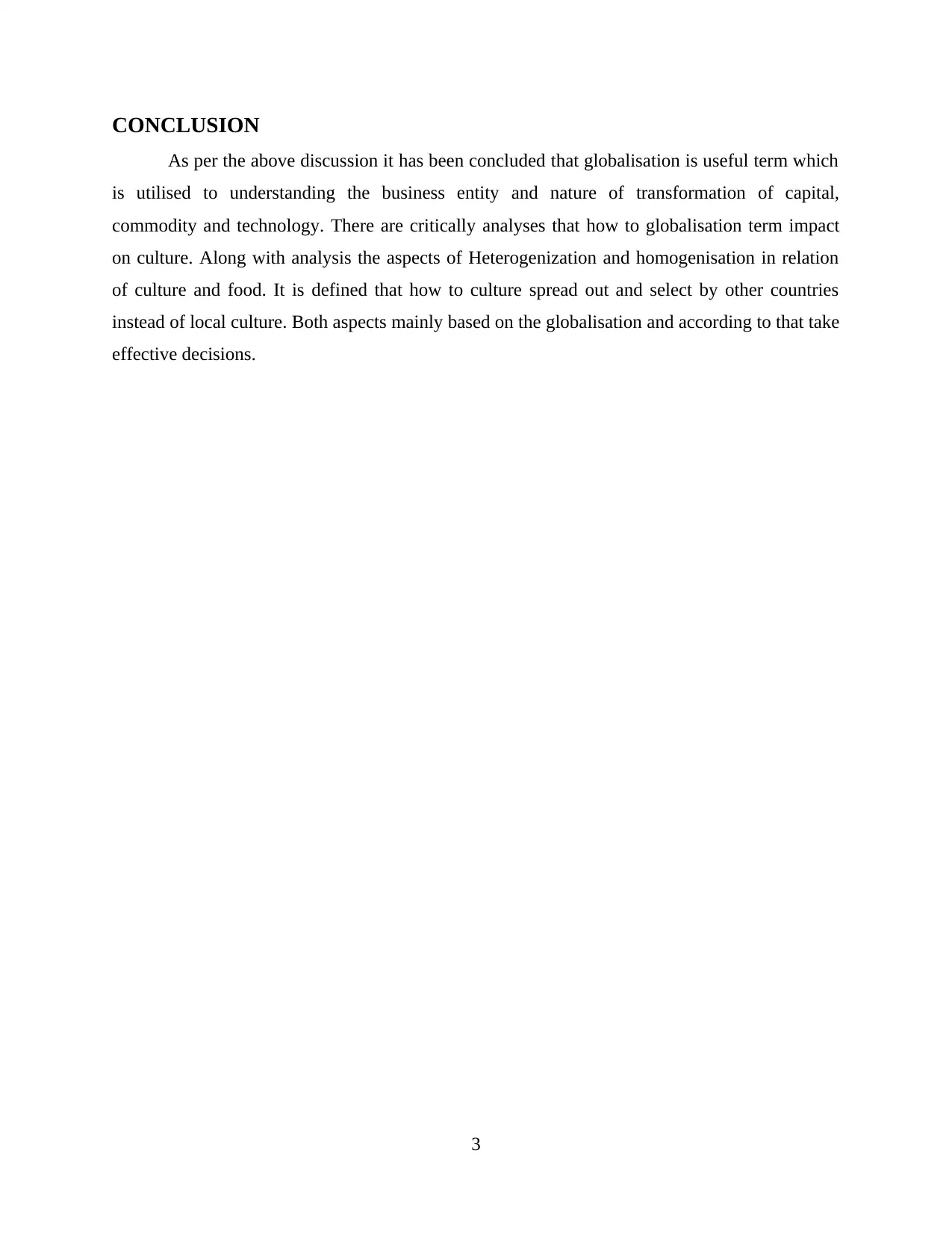
CONCLUSION
As per the above discussion it has been concluded that globalisation is useful term which
is utilised to understanding the business entity and nature of transformation of capital,
commodity and technology. There are critically analyses that how to globalisation term impact
on culture. Along with analysis the aspects of Heterogenization and homogenisation in relation
of culture and food. It is defined that how to culture spread out and select by other countries
instead of local culture. Both aspects mainly based on the globalisation and according to that take
effective decisions.
3
As per the above discussion it has been concluded that globalisation is useful term which
is utilised to understanding the business entity and nature of transformation of capital,
commodity and technology. There are critically analyses that how to globalisation term impact
on culture. Along with analysis the aspects of Heterogenization and homogenisation in relation
of culture and food. It is defined that how to culture spread out and select by other countries
instead of local culture. Both aspects mainly based on the globalisation and according to that take
effective decisions.
3
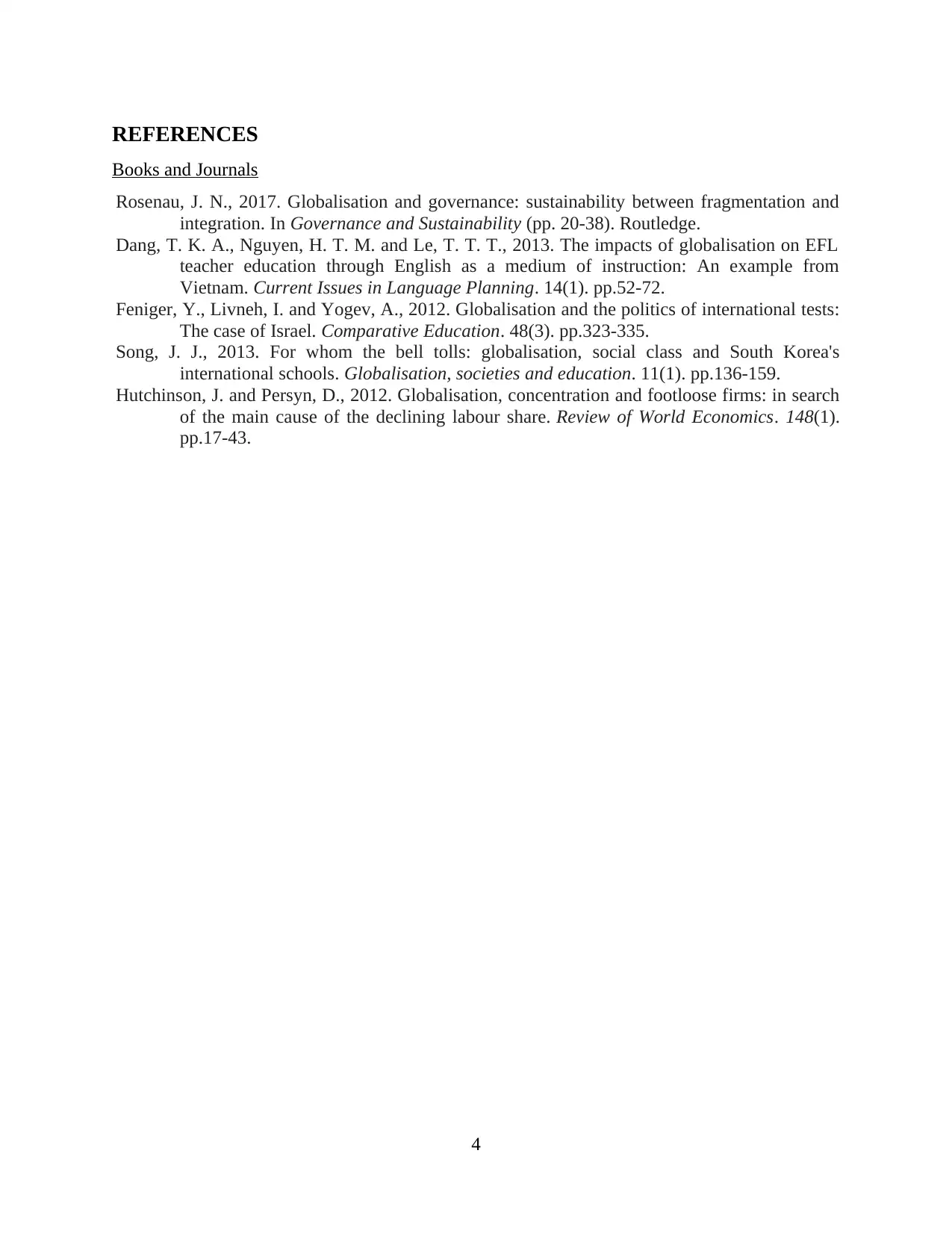
REFERENCES
Books and Journals
Rosenau, J. N., 2017. Globalisation and governance: sustainability between fragmentation and
integration. In Governance and Sustainability (pp. 20-38). Routledge.
Dang, T. K. A., Nguyen, H. T. M. and Le, T. T. T., 2013. The impacts of globalisation on EFL
teacher education through English as a medium of instruction: An example from
Vietnam. Current Issues in Language Planning. 14(1). pp.52-72.
Feniger, Y., Livneh, I. and Yogev, A., 2012. Globalisation and the politics of international tests:
The case of Israel. Comparative Education. 48(3). pp.323-335.
Song, J. J., 2013. For whom the bell tolls: globalisation, social class and South Korea's
international schools. Globalisation, societies and education. 11(1). pp.136-159.
Hutchinson, J. and Persyn, D., 2012. Globalisation, concentration and footloose firms: in search
of the main cause of the declining labour share. Review of World Economics. 148(1).
pp.17-43.
4
Books and Journals
Rosenau, J. N., 2017. Globalisation and governance: sustainability between fragmentation and
integration. In Governance and Sustainability (pp. 20-38). Routledge.
Dang, T. K. A., Nguyen, H. T. M. and Le, T. T. T., 2013. The impacts of globalisation on EFL
teacher education through English as a medium of instruction: An example from
Vietnam. Current Issues in Language Planning. 14(1). pp.52-72.
Feniger, Y., Livneh, I. and Yogev, A., 2012. Globalisation and the politics of international tests:
The case of Israel. Comparative Education. 48(3). pp.323-335.
Song, J. J., 2013. For whom the bell tolls: globalisation, social class and South Korea's
international schools. Globalisation, societies and education. 11(1). pp.136-159.
Hutchinson, J. and Persyn, D., 2012. Globalisation, concentration and footloose firms: in search
of the main cause of the declining labour share. Review of World Economics. 148(1).
pp.17-43.
4
⊘ This is a preview!⊘
Do you want full access?
Subscribe today to unlock all pages.

Trusted by 1+ million students worldwide
1 out of 6
Related Documents
Your All-in-One AI-Powered Toolkit for Academic Success.
+13062052269
info@desklib.com
Available 24*7 on WhatsApp / Email
![[object Object]](/_next/static/media/star-bottom.7253800d.svg)
Unlock your academic potential
Copyright © 2020–2025 A2Z Services. All Rights Reserved. Developed and managed by ZUCOL.





